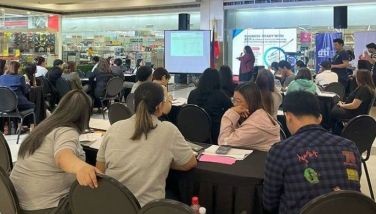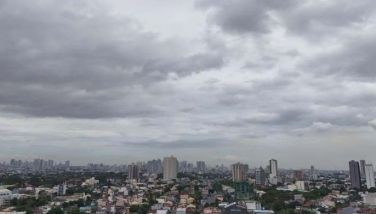Flooded by corruption

If we are to rely on the weather forecast of our state-run Philippine Atmospheric, Geophysical and Astronomical Services Administration (PAGASA), there will be at least six more tropical cyclones to visit our country before the end of this year. The first two, PAGASA announced last Friday, are expected to enter this month the Philippine area of responsibility, or PAR for short.
We just had one after the other “severe tropical storms” named “Kristine” and “Leon” as the 11th and 12th typhoons this year that entered the PAR. According to PAGASA, our country experiences an average of 20 typhoons each year, with about eight or nine of them crossing the Philippine landmass.
Fortunately, the last two cyclones weakened and did not reach the level of “super typhoon” after making landfall in our country. The term “super typhoon” is used when a typhoon’s sustained surface-wind strength reaches 240 kilometers (150 miles) per hour, the equivalent of a strong category 4 or category 5 hurricane. We could only be thankful to God in giving our archipelagic country its natural defenses like the Sierra Madre mountain range in Luzon.
Our PAGASA weather specialists noted the peak of our typhoon season is from July through October, during which period nearly 70 percent of all typhoons develop. The PAGASA website states: “The Philippines is prone to tropical cyclones due to its geographical location which generally produce heavy rains and flooding of large areas and also strong winds which result in heavy casualties to human life and destruction to crops and properties. Thus, it is of utmost importance to have sufficient knowledge on such maritime phenomena for beneficial purposes.”
With such certainty and predictability of our weather condition, mass casualty events during typhoons still occur in our country.
While it did not develop into a super typhoon, Kristine left behind as many as 150 people dead, with 122 injured and 30 individuals still reported missing. This was based on the last monitoring of calamity reports of the National Disaster Risk Reduction Management Council (NDRMMC). While the bulk of reported dead due to Kristine-induced landslides were mostly from Batangas, the NDRRMC reported that Bicol Region is still the hardest hit by heavy rains, landslides and massive flooding.
In fact, many areas in Albay and Camarines Sur remain flooded up to now, though in some parts the floods have substantially receded to knee-deep as of Friday. Barely a few days later, Leon struck and likewise caused widespread devastation, especially in Batanes, Cagayan and nearby northern Luzon provinces.
The NDRMMC reported as many as 81,716 families or 311,980 people remain temporarily housed in 1,980 different evacuation centers in various affected provinces and localities from 17 different regions. Although the National Capital Region was not directly hit, rains brought by Kristine resulted in the usual heavy flooding around low-lying areas in Metro Manila.
In parts of flood-prone Parañaque City, dozens were stranded along Dr. Arcadio Santos Avenue at the height of Kristine until the wee hours of the next morning. Even trucks, buses and other big vehicles were stalled in the middle of the road as vehicles ahead of them opted not to proceed into the thigh-high flooding. Although government employees and schoolchildren have been spared by the suspension of work and classes, respectively, many of us lesser mortals who have to work and report to office even during typhoons waded through the flood.
Many could not go home due to limited transport options because flooding rendered many roads unpassable. Some cars also broke down due to floods, which also caused traffic jams in the area. Stranded individuals were saved, picked up and rescued in rubber boats and several military trucks that were offered to those who needed a ride to their areas of destination.
Bleeding hearts, especially from leaders and members of Congress, including those from the national and local governments, were only too quick to be seen distributing relief goods and assisting in flood and disaster-stricken areas.
Yes, President Ferdinand “Bongbong” Marcos Jr. (PBBM) always convenes and meets with his Cabinet officials who are members of the NDRMMC before and after typhoon disasters. However, PBBM cannot just scratch his head and ask them: “But what can we do?”
And the worst part of this problem is how much public funds were lost to corruption in the many big-funded flood control projects all over the country. The biggest question was: “Where did the money in the more than P61.4-billion flood control budgets for the past two years in Bicol go?”
Senator Joel Villanueva, in particular, noted there was P29.4 billion that was allocated to the DPWH budget in flood control projects for Bicol alone in the Congress-approved 2023 General Appropriations Act (GAA). Sen. Villanueva further noted there was P31.9 billion for DPWH flood control projects in Bicol under the 2024 GAA, or a total of P61.4 billion for two years of the budget cycle.
Disclaimer: I am not related to the senator though he claims to be a distant relative from Bulacan.
Sen. Villanueva recalled having raised this question already at the budget plenary that as much as P1.44 billion a day was supposed to be spent for flood control measures by several government agencies implementing them. These included the Department of Public Works and Highways (DPWH); the Department of Environment and Natural Resources (DENR); the Climate Change Commission (CCC) and the Metro Manila Development Authority (MMDA), he cited.
DPWH Secretary Manuel Bonoan was stupified to tell a House budget hearing having discovered “nothing was actually allocated” in the P70-billion counterpart funding for foreign-assisted projects of the agency. Bonoan claimed he was “surprised” when the Congress-approved 2024 GAA came out without it. So where did such a huge amount go?
This hocus-pocus happens behind closed-door GAA bicameral conference committee meetings of Congress.
This is why Filipinos feel frustrated and disappointed to hear laments whenever these catastrophic events are being blamed on climate change. We know that already. Thus, it requires whole-of-nation mitigating and adaptation solutions before these public funds literally go down the drain due to corruption.
- Latest
- Trending





























